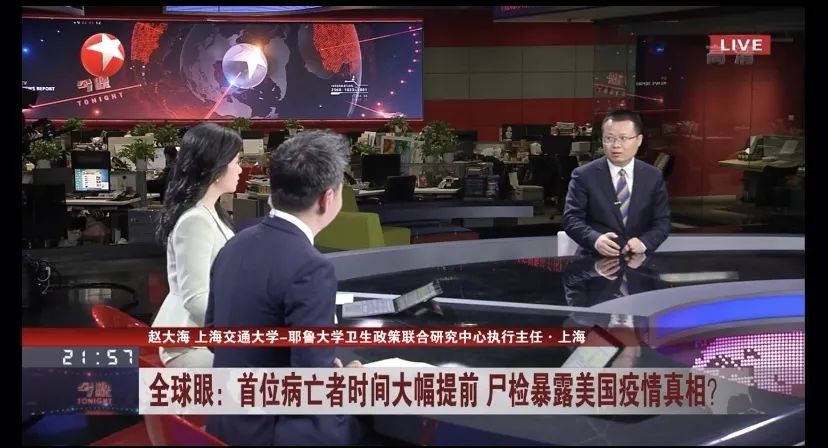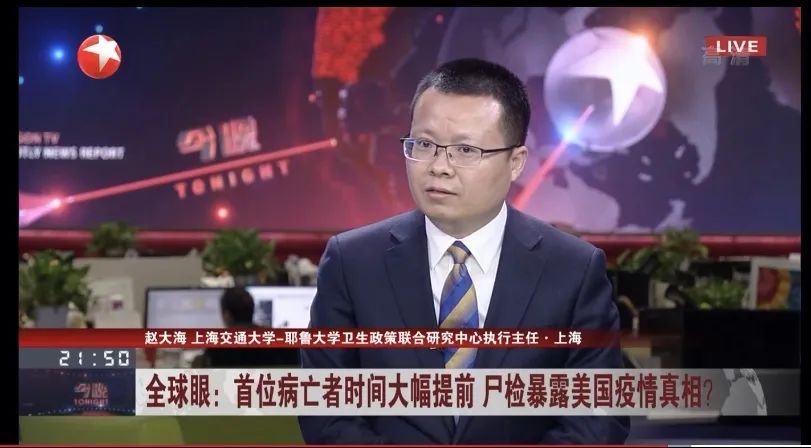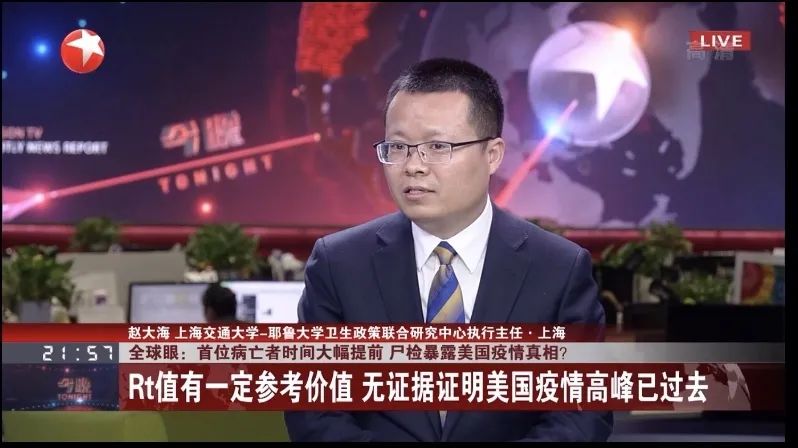上海交大赵大海关于新冠疫情第23次在电视台访谈评论:美国加州和纽约州的相关工作将有助于揭开新冠疫情真相
上海交通大学国际与公共事务学院博士生导师、上海交通大学-耶鲁大学卫生政策联合研究中心执行主任赵大海,自新冠肺炎疫情以来第8次做客上海电视台演播厅进行直播评论,也是第23次在央视/上视进行直播评论。2020年4月24日,赵大海做客东方卫视演播厅,在21点20分的《今晚》节目,对美国加州州长要求对去年底的相关尸体进行重新检测、纽约州进行的血清抗体筛检以及美国总体疫情进展等进行了评论。现将主要内容摘录如下。
主持人:赵先生晚上好,我们看到加州的州长说,如果他把过去五个月死亡的尸体进行重新检测,有没有可能改变美国的这个疫情的时间线?
赵大海:现在美国官方所公布的新冠肺炎的感染的时间是2月28号。根据本周三,在加州圣克拉拉县的相关尸检的检测,其中最早的一起是2月6号死亡的,而且这一例死亡是之前感染过新冠肺炎病毒的。如果加州州长要求在更大样本的相关死亡患者当中进行这个检测的话,非常有可能让美国新冠肺炎感染的时间线大幅度提前,而2月6号假定是最早的话,感染时间就已至少能推到一月中旬左右。

主持人:如果说时间线真的提前的话,那么这可能会暴露什么样的问题?
赵大海:在某种程度上可以佐证新冠肺炎病毒到底从哪里来的。比如说现在加州所尸检的这3例患者当中,没有一例来过中国。如果在更大的样本当中,可以推到去年12月底患者死亡的样本当中的话,可能进一步能够在很大程度上解答新冠肺炎的病毒从哪来的?到底是来自于我们中国的武汉还是美国的本土还是其他的地方,至少是能在这个新冠肺炎病毒的源头上起到一个很好的解释作用;第二,就是说因为加州是属于美国民主党最大的票仓,如果加州能够确定出新冠肺炎病毒的感染时间大幅度的提前于美国公布的这个二月底的话,会在很大程度上佐证特朗普在新冠肺炎暴发前期的防控措施的不利,可能会为今年11月份美国总统大选为民主党带来很多的便利。

主持人:你怎么看纽约州州长科莫提到的随机检测了3000人的这个数据,13.9%的人有阳性,我们可不可以根据这个13.9%的这个数字的比例,来推断目前所公布的美国确诊的这个人数的数据。
赵大海:对于现在没有症状的人群开展新冠肺炎血清抗体的检测,不止是纽约在做,美国其他州也在尝试着做这方面的工作。其他国家也在做,甚至包括我们中国某些地方也已经在开展血清抗体的检测。可以说,在很大程度上,血清抗体的检测可更接近全面了解这个病毒本身;另外一个方面,只在3000个非完全随机的人群样本当中进行抽样,现在这个接近14%的数据,样本量不是很大,抽样方法也不是特别的科学。目前14%的数据有一定的参考价值,但是其真实性和可靠性还有待于在更大的样本当中采用更科学的随机抽样的方法来进一步的确定或核实。
主持人:您觉得我们通过这个Rt值,它反映出了美国疫情什么样的情况?现在是不是高峰就已经过去了。
赵大海:Rt值有一定的参考价值。如果Rt的数据是非常真实的,按照这个曲线来看,现在这个传播的速度比较平稳,倒没有办法来论证它已经过去了,至少是比较平稳。但是Rt值有一个非常大的局限,就是说它的数据完全来自于各州上报的数据,刚才我们讲到纽约州的时候,如果14%的数据是真实的话,那么大部分确诊患者数据还没有上报,也就是这个Rt值,它有很大的局限,而且没有证据证明美国疫情现在已经过去了。
主持人:白宫一直是非常着急的想要重启经济。那在您看来,如果在这个时候来重启经济,解除居家隔离,这会给美国的疫情带来怎样的影响?
赵大海:按照我们中国人的说法,就是复工复产。美国各级政府,包括州政府,也包括联邦政府,对于复工复产是非常着急。因为美国现在报上来的数据是2600万人失业,这对于美国整个经济,包括对于老百姓的生活而言有很大的负面影响。应该讲是可以理解他们着急要进行解封。另外更为重要的就是说,因为美国现在远远还没有到这个疫情完全可控的地步,如果比较仓促地解封,让很多原本居家隔离的人复工复产的话,应该会按照美国的说法叫反弹,其实美国现在还没有疫情可控,谈不上反弹,应该说可能会导致更大一轮的疫情暴发。
供稿者:国务学院
日期:2020年4月25日
Dahai Zhao' 23th comments on TV during the Pandemic: California and New York are contributing to learning more origins about COVID-19
Dahai Zhao, a doctoral supervisor at School of International and Public Affairs of Shanghai Jiao Tong University and Executive Director of Shanghai Jiao Tong University-Yale University Joint Research Center for Health Policy, has been interviewed by Dongfang TV for the 8th time (the 23th time by CGTV / DFTV) since the COVID-19 pandemic. At 21:20 on April 24, 2020, Zhao commented on governor of California requesting for retesting of the bodies at the end of last year, New York state testing for serum antibodies, and the overall state of the epidemic on “Tonight”.
Anchor: Good evening, Mr. Zhao. We've seen the governor of California say that if he re-tests the bodies of people who have died in the last five months, is it possible to change the timeline of this outbreak in the United States?
Zhao: U.S. officials now say COVID-19 happened on Feb. 28. According to a coroner's autopsy in Santa Clara county, calif., on Wednesday, the earliest death was on Feb. 6, and the death was from a previous infection with COVID-19. If the governor of California calls for this test in a larger sample of related deaths, it is likely to bring forward the timeline of COVID 19 infection in the United States significantly. On the assumption that Feb. 6 is the earliest, the infection has been pushed back to at least mid-January.
Anchor: If the timeline is indeed ahead of schedule, what might this reveal?
Zhao: To some extent, where did COVID-19 virus come from. None of the three patients tested in California, for example, had ever been to China. If a larger sample can be extrapolated to a sample of patients who died at the end of December, it may go a long way toward explaining where COVID-19 came from. Whether it came from Wuhan in China or from the mainland of United States or somewhere else, at least, is a good explanation for the origin of COVID-19 infections. Second, California is the largest democratic voting state in the United States. If California can confirm that the infection time of COVID-19 is significantly earlier than that of the end of February announced in the United States, it will largely prove the disadvantage of Trump's prevention and control measures in the early stage of the outbreak of COVID-19, which could be a boon for the Democrats in the US presidential election in November.
Anchor: What do you think of the data that governor Andrew Cuomo mentioned about the random test of 3,000 people, 13.9% of them were positive? Can we infer from the proportion of that 13.9% that the number of people diagnosed in the United States has been published so far?
Zhao: Testing for serum COVID-19 antibodies in people who currently have no symptoms is not only being done in New York, but other states in the United States are trying to do the same thing. Other countries are doing it, and even some places in China are already doing it. For the most part, the detection of serum antibodies is closer to a complete understanding of the virus itself. On the other hand, they only sampled 3,000 people who were not completely random, which is close to 14% now. The sample size is not very large, and the sampling method is not particularly scientific. Currently, the 14% has some reference value, but its authenticity and reliability still need to be further confirmed or verified by more scientific random sampling methods in a larger sample.
Anchor: What do you think this Rt value tells us about the outbreak in the United States? Is the peak over now?
Zhao: Rt value has certain reference value. If the Rt data is very real, and if you look at this curve, now the velocity is fairly steady, there's no way to argue that it's over, at least fairly smooth. But Rt has a big limitation, which is that its data comes entirely from state-reported data. When we talked about the state of New York, if the 14 percent figure is true, then most of the confirmed patients have not been reported. That's Rt, which is very limited, and there's no evidence that the U.S. outbreak is now over.
Anchor: The White House has been very anxious to re-open the economy. In your opinion, if this is the time to restart the economy and remove home quarantine, how will that affect the epidemic in the United States?
Zhao: According to our Chinese saying, it is to return to work and production. All levels of government, state and federal, are anxious to get back to work. Because the U.S. is now reporting 26 million unemployed, this has a significant negative impact on the entire U.S. economy, including the lives of ordinary people. It is understandable that they are anxious to lift closure. More importantly, because the United States is far from being able to get the outbreak under control, a hasty unclosure and the return to work and labor of many people who had been quarantined at home would be called a rebound, as the United States calls it. In fact, the United States is not yet under control of the outbreak, there is no rebound, should be said to lead to a larger outbreak.
Contributor: SIPA, SJTU
Date: April 25

